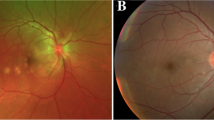Summary
Acute syphilitic posterior placoid chorioretinitis (ASPPC) has been described as a rare chorioretinal manifestation in patients with secondary syphilis. The fundus changes may simulate other chorioretinal disorders and thus delay an accurate diagnosis and initiation of appropriate pharmacological therapy.
Patient: A 54-year-old male patient presented with severely impaired visual acuity in both eyes. Yellowish geographic lesions were noted at the posterior pole. Scanning laser ophthalmoscopy showed corresponding areas of increased fundus autofluorescence. On fluorescein angiography hypofluorescent lesions were noted in the early phase, which became hyperfluorescent in later frames. Indocyanine green agiography demonstrated hypofluorescent lesions both during the early and late frames. Serological examinations were positive for secondary lues (TPHA, FTA-IgM, cardiolipin antibody). Treatment with penicillin was introduced, resulting in complete functional and morphological recovery.
Conclusion: Fundus and angiographic changes in ASPPC may mimic other chorioretinal diseases, including acute posterior multifocal placoid pigmentepitheliopathy (APMPPE). The angiographic findings suggest that inflammation-associated perfusion abnormalities of the choriocapillaris contribute to the pathophysiological process. Accurate diagnosis of ASPPC as a presenting sign of secondary lues is especially important for the prompt initiation of systemic antibiotic treatment.
Zusammenfassung
Die akute syphilitische posteriore plakoide Chorioretinopathie (ASPPC) stellt eine seltene Manifestation der Lues II dar. Ähnlichkeiten mit anderen Erkrankungen des hinteren Augenpols können die differentialdiagnostische Abgrenzung erschweren, insbesondere, wenn die Grunderkrankung unbekannt ist.
Patient: Ein 54jähriger Patient stellte sich wegen zunächst ein-, dann auch beidseitiger erheblicher Visusminderung vor. Der zentrale Fundus zeigte geographische, gelbliche Areale, die mit einer vermehrten Autofluoreszenz einhergingen. Fluoreszeinangiographisch waren diese Bereiche zunächst hypofluoreszent und im Verlauf zunehmend hyperfluoreszent. In der Indozyaningrün-Angiographie stellten sich die entsprechenden Areale durchgehend hypofluoreszent dar. Serologische Untersuchungen lieferten den Beweis für eine Lues-II-Infektion. Nach dreiwöchiger Penicillintherapie kam es zu einem Rückgang der Fundusveränderung mit Visusnormalisierung.
Schlußfolgerung: Die morphologischen und angiographischen Befunde bei ASPPC können andere chorioretinale Erkrankungen einschließlich der akuten posterioren multifokalen plakoiden Pigmentepitheliopathie (APMPPE) simulieren. Die angiographischen Charakteristika unterstützen die Annahme, daß der ASPPC eine Perfusionsstörung der Choriokapillaris zugrundeliegt. Die richtige Diagnose der Grunderkrankung ist insbesondere für die rasche Einleitung einer systemischen Antibiotikatherapie bedeutsam.
Similar content being viewed by others
Author information
Authors and Affiliations
Rights and permissions
About this article
Cite this article
Bellmann, C., Holz, F., Breitbart, A. et al. Bilateral acute syphilitic posterior placoid chorioretinopathy – angiographic and autofluorescence characteristics. Ophthalmologe 96, 522–528 (1999). https://doi.org/10.1007/s003470050448
Published:
Issue Date:
DOI: https://doi.org/10.1007/s003470050448




